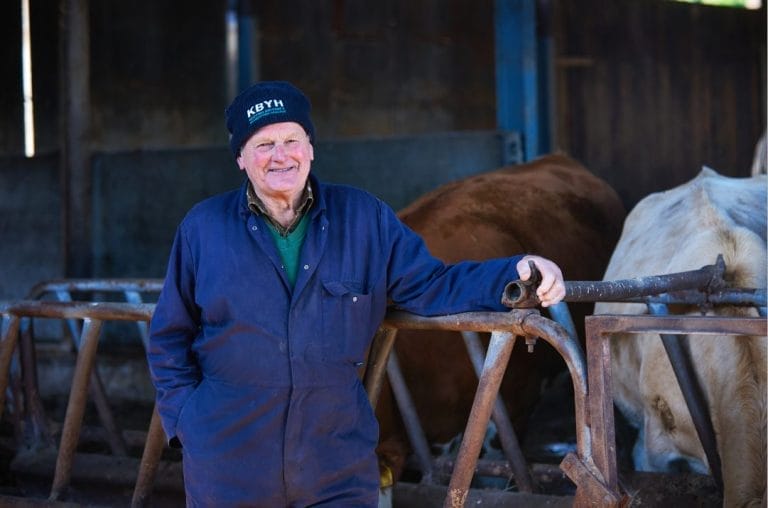
A bumper 2023 maize crop looks set to eliminate any future risks of running short of a key forage for one high yielding Dorset dairy herd.
According to Robert Symms, who farms with his wife Bryony and son Jake at Batsons Farm, near Sherborne, growing a slightly increased maize acreage and opting for a top-ranked very early maturing variety should ensure the availability of important carryover silage stocks come the autumn of 2024.
“We’re estimating that we’ve clamped around 2,800 tonnes of maize this year, from 143 acres, so pretty much 20 tonnes/acre,” Robert reports. “That should mean we’ll have enough to last until Christmas 2024, so we can maintain a consistent ration all year round and avoid the issues of previous years when we’ve run short of maize before the new crop is fully fermented.”
Batsons Farm has evolved significantly over the last decade or so, firstly converting to a fully housed operation around 10 years ago, and in the last 12 months moving over to robotic milking. Over this period, a forage ration comprising approximately 60% maize and 40% grass silage has become established, fed as part of a total mixed ration through a forage wagon and underpinning yields that are now pushing up towards 12,500 litres/cow.
 The herd currently numbers 220 milking cows, with Robert conscious of the danger of any shortfall in maize production. He therefore turned to his seed supplier, Tim Rutter of Pearce Seeds, for advice on how to boost maize output.
The herd currently numbers 220 milking cows, with Robert conscious of the danger of any shortfall in maize production. He therefore turned to his seed supplier, Tim Rutter of Pearce Seeds, for advice on how to boost maize output.
“Based on the fact that we needed more yield, but still wanted a mature crop harvested before the end of September, Tim recommended Dignity from Limagrain,” Robert adds. “As a new variety, it had performed very well in Pearce Seeds’ own local trials and had all the attributes we were looking for.
“It was £10 a pack more than some of the other alternatives, but it has certainly performed for us, and I can now say it has been well worth the extra investment.”
Maize is usually drilled at Batsons Farm during the first week of May, and 2023 was no exception. It follows an over-winter cover crop of westerwold ryegrass, which provides a bonus cut of forage in early April and helps avoid the risks of bare ground during the wetter months.
“The cover crop will have had slurry on it in March and we apply farmyard manure after we’ve taken the cut of silage,” says Robert. “We then plough in the ryegrass stubble and prepare the ground for drilling with one or two passes with the power harrow. The maize is drilled by our contractor and goes in with one hundredweight to the acre of DAP down the spout. We’ve never seen the benefit of top dressing with any additional nitrogen fertiliser, so it’s simply a case of then allowing our agronomist to advise on herbicides, but our crops are generally pretty clean.”
In what has been a favourable year for growing maize in Dorset, the Dignity has performed exceptionally well,
maturing in good time for harvest before the end of September and yielding an impressive 20 tonnes/acre. Early sampling of the fresh, unfermented crop, taken from the clamp, revealed a dry matter of 34% and an ME of 11.2 MJ/kg, with starch at 28.6%. By the end of November, the fermented crop was analysed at 39.3% DM and 39.0% starch, with an ME of 11.96 MJ/kg. The ensiled crop was also shown to have a high percentage of fast digesting fibre and a low content of non-digestible fibre, both of which will ensure the crop feeds well and is easily assimilated in the rumen.
According to the farm’s nutritionist Vicky Ham, of Kite Consulting, forage budgeting that will, in future, allow the new maize to remain untouched for two or three months will be beneficial to overall herd performance.
“At Batsons Farm, the maize offers vital energy and a safe source of starch and is the foundation for the milkers and dry cow rations. We aim to feed a ratio of 60:40 maize to grass silage but can only do this with adequate silage stocks and fully fermented maize silage.
“When stocks run short, as we’ve seen this year and in previous years, there’s a risk of upsetting the rumen balance, and feeding the maize before the starch is at its most digestible equates to lost production potential.
“With the increased stocks resulting from the improved 2023 harvest with LG Dignity, we’re in a much better position from a forage budgeting perspective. Next year the new-season maize should remain untouched for two to three months after clamping and that will mean we’re maximising its value in the ration.”
With regards to the grass silage component of the ration, the Symms have moved towards a multi-cut system in recent years, starting early and taking as many as five or even six cuts a season, to maximise silage quality.
With input again from Pearce Seeds, they are now looking at four-to-five-year leys, with the addition of very large leaf white clover, which will not only boost the protein value of the grass silage but could also help to secure additional payments through the new Sustainable Farming Incentive schemes.


































